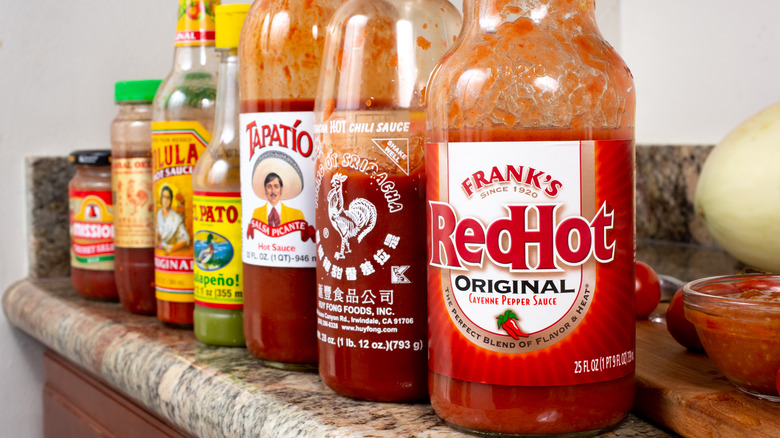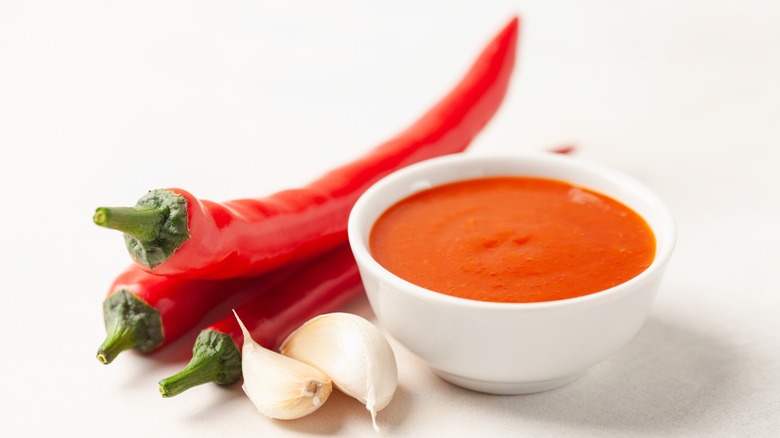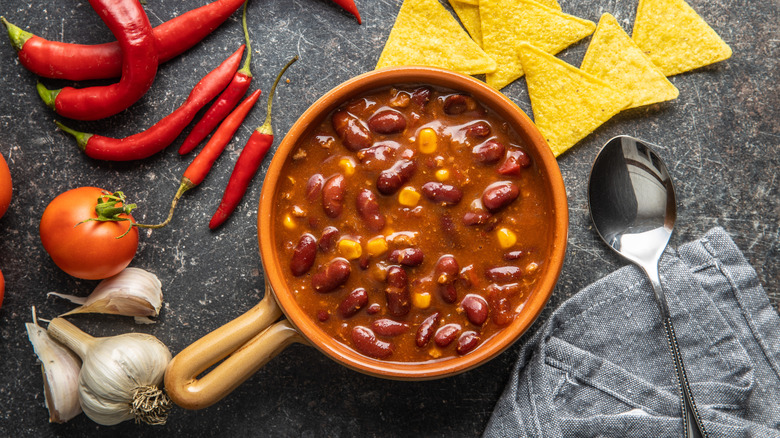The Subtle Difference Between Picante And Louisiana-Style Hot Sauce
Picture this: It's Sunday morning in a busy restaurant. People are ordering brunch favorites like eggs Benedict or chilaquiles. Plates arrive and right away a diner raises his hand and asks the server for that one special thing that will make the dish just perfect — hot sauce.
Anyone who isn't a heat seeker or a hot sauce connoisseur might assume that all hot sauces are created equal, but in fact, that is not the case. While there are many types of hot sauce on the market, there are two styles that are exceedingly likely to be found on a restaurant table: Louisiana-style hot sauce and picante or Mexican-style hot sauce. Popular brands of picante-style hot sauce include Cholula, Valentina, and Tapatío, while popular brands of Louisiana-style hot sauce include Tabasco, Frank's Red Hot, Crystal, and Louisiana Hot Sauce (via The Washington Post).
Should they be used interchangeably? There are some subtle differences between picante and Louisiana-style hot sauces that make them unique and perfect for different types of dishes. But first, a bit about how they're made.
Louisiana-style hot sauce is more acidic
When it comes to hot sauce brands, Tabasco is the granddaddy of them all. Per the Washington Post, Tabasco was the first hot sauce company to bottle and sell to restaurants and hotels. Its first sales date back to the 1800s, and its reputation certainly hasn't cooled down since then.
Tabasco is a Louisiana-style hot sauce, which means that it — along with cousins like Crystal, Frank's Red Hot, and the aptly named Louisiana — is made up primarily of chilies, vinegar, and salt. Traditional Cajun and Creole dishes are known for their spice, but some of the credit goes to the signature Louisiana-style sauce that can be added at the table.
Picante sauces like Cholula, Valentina, or Tapatio brands have different formulas. According to Taste of Home, picante hot sauces use little to no vinegar and instead rely mostly on a combination of smoked chilies like chipotles, as well as jalapeños, habaneros, and pequins to impart flavor. (Fun fact: Picante means spicy in Spanish.) These hot sauces are less acidic; they get more flavor from chilies and less tang from vinegar. In fact, flavor is king among these particular sauces: According to ATX Hot Sauce, picante focuses on flavor above almost everything else, even heat.
Where and how to use hot sauces
With the distinct differences between these two styles of hot sauces, you might wonder where and how to best use them. Taste of Home recommends using picante hot sauces in soups and stews to add a little bit of heat. They can also be sprinkled on traditional Mexican dishes like tacos, enchiladas, and burritos, or added to Mexican rice to give it some extra flavor.
Louisiana-style hot sauces, on the other hand, are great in traditional Cajun or Creole dishes like red beans and rice, gumbo, or shrimp etouffee. Not to mention, brands like Frank's Red Hot are the key ingredient in most traditional Buffalo wing recipes (via The Chicago Tribune). Louisiana-style sauces are also great if you're looking to add both heat and salt to a dish with just one ingredient.
For some non-traditional uses, Serious Eats recommends trying any kind of hot sauce drizzled over burgers or hot dogs — and adding a few drops to your birdseed can even help keep squirrels away. And as for eggs at brunch? It seems like either style of hot sauce can offer a satisfying kick depending on your preference. For a salty tanginess, choose a Louisiana-style hot sauce; for a flavorful smokiness, go with a picante.


